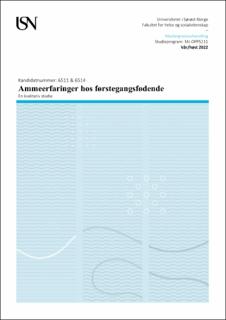| dc.contributor.advisor | Sommerseth, Eva | |
| dc.contributor.author | Breiland, Kristina | |
| dc.contributor.author | Thorsen, Charlotte | |
| dc.date.accessioned | 2022-08-11T16:43:04Z | |
| dc.date.available | 2022-08-11T16:43:04Z | |
| dc.date.issued | 2022 | |
| dc.identifier | no.usn:wiseflow:6592802:50400986 | |
| dc.identifier.uri | https://hdl.handle.net/11250/3011434 | |
| dc.description.abstract | Bakgrunn: Morsmelk har mange gode helsegevinster for både mor og barn, derfor anbefaler Verdens helseorganisasjon (WHO) fullamming til alle spedbarn frem til fylte 6 måneder. Globalt sett fullammes kun 41% av alle barn. Tall fra Norge viser at 44% fullammer barna sine etter 4 måneders alder, og kun 17% fullammer ved 5,5 måneds alder. Vi ønsket å se nærmere på hvorfor antall fullammede barn reduseres over tid det første halve leveåret, til tross WHO sin anbefaling, og de gode helsegevinstene ved å gi barnet morsmelk.
Mål: Identifisere ammeutfordringer hos kvinner som har ønsket å fullamme, men som ikke har fått det til. Videre er det ønskelig å se på om det finnes tiltak for å forebygge disse utfordringene som fører til tidlig ammeslutt, slik at flere kvinner på sikt kan få til fullamming i 6 måneder.
Metode: En kvalitativ studie med semistrukturerte individualintervjuer fra 10 førstegangsfødende kvinner, fra alle landsdeler i Norge.
Resultater: Deltakerne i studien opplever avvik i forbindelse med ammeinformasjon – og veiledning både i svangerskapsomsorgen, under sykehusoppholdet etter fødsel og helsestasjonen i barseltiden. For lite og for dårlig informasjon og veiledning er to faktorer som skiller seg ut, og baserer seg på helsepersonellets tidspress på jobb og mangel på kunnskap for å klare å veilede kvinner med ammeutfordringer. Dette medfører ufrivillig tidlig ammeslutt hos førstegangsfødende kvinner. Den vanligste utfordringen som oppstår i forbindelse med tidlig ammeslutt er utilstrekkelig melkeproduksjon. Kvinnene forteller også om et ammepress i samfunnet som medfører stigmatisering og en følelse av skam.
Konklusjon: Det bør rettes mer fokus på å øke kunnskapen om amming til helsepersonell som arbeider med gravide og barselkvinner, og det bør prioriteres mer tid til individualisert ammeveiledning både i svangerskapsomsorgen og i barselomsorgen for å fremme ammevarigheten for førstegangsfødende kvinner i Norge. Det finnes en rekke tiltak man kan forsøke ved lav melkeproduksjon. Tiltakene må dog individualiseres den enkelte kvinne. Tiltak for å øke melkeproduksjonen og på sikt øke ammevarigheten er: god informasjon – og veiledning til kvinnene, tidlig ammestart, pumpe etter amming, legge barnet til brystet oftere, hud – til – hud kontakt, fremme ro og velvære, forhindre stress, god ammestilling, godt sugetak, hjelpemidler som hjelpebryst, brystskjold og oksytocinspray. Helsepersonell bør bli mer kritiske i bruken av morsmelkerstatning, og kun gi dette på medisinsk grunnlag, da dette er en ødeleggende faktor for amming. Kvinner som ufrivillig må gi opp ammingen bør følges tettere av helsepersonell av hensyn til deres psykiske helse. | |
| dc.description.abstract | Background: Breast milk has many good health benefits for both mother and child, therefore the World Health Organization (WHO) recommends exclusive breastfeeding for all infants up to 6 months of age. Globally, only 41% of all infants are exclusively breastfed. Numbers from Norway shows that 44% are exclusively breastfeeding their infants after 4 months of age, and only 17% exclusively breastfeed their infants at 5,5 months of age. We wanted to find out why the number of exclusively breastfed infants is reduced over time in the first 6 months, despite the WHO`s recommendation, and the good health benefits of giving the infant breast milk.
Aim: Identify breastfeeding challenges in women who have wanted to breastfeed, but who have not succeeded. Furthermore, it is desirable to look at whether there are measures to prevent these challenges that lead to early breastfeeding, so that more women can eventually succeed exclusive breastfeeding for 6 months.
Method: A qualitative study with semi – structured individual interviews from 10 first – time mothers, from all parts of Norway.
Findings: The participants in the study experienced deviations with breastfeeding information – and guidance in the maternity care, in the hospital stay after giving birth and the health station during maternity leave. They experienced that the information and guidance that was given, was not sufficient, and they believed that the reason behind this was because of the lack of knowledge of breastfeeding challenges in healthcare workers, and theirs time pressure at work. This causes early cessation of breastfeeding in first – time mothers. The most common challenge that arises in connection with early cessation of breastfeeding is insufficient milk production. The women also talk about stigma in the society in conjunction with not breastfeeding their infant.
Conclusion: More focus should be placed on increasing knowledge about breastfeeding for health professionals working with pregnant women and women in maternity leave. Individualized breastfeeding guidance should be given priority in both maternity care and maternity leave to promote the duration of breastfeeding for first – time mothers in Norway. There are different measures to try against low milk production. The measures to increase milk production and eventually, increase the duration of breastfeeding are: good information – and guidance for women, early breastfeeding, pumping after breastfeeding, adding the baby to the breast more often, skin – to – skin contact, promoting calm and well – being, preventing stress, good breastfeeding position, good suction, aids such as supplemental nursing system (SNS), breast shield and oxytocin spray. Health care professionals should be more critical in the use of infant formula, and only give this on a medical basis, as this is a destructive factor for breastfeeding. Women who have to involuntarily give up breastfeeding should be followed more closely by healthcare professionals for the sake of their mental health. | |
| dc.language | nob | |
| dc.publisher | University of South-Eastern Norway | |
| dc.title | Ammeerfaringer hos førstegangsfødende | |
| dc.type | Master thesis | |
